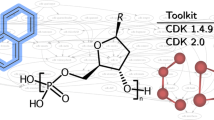Abstract
Molecular computer graphics (MCG) has become the indispensable complement of experimental chemical and biological tools and, in a way, will shape the evolution of these fields. This accelerated and popularized evolution takes root in the visual, even scenic, grasping of fundamental chemical concepts, perceived as veritable ideograms, which condense a vast amount of information with a few two- or threedimensional graphic symbols. With MCG one can carry out real computerized syntheses of chemical images. MCG is also an ideal tool through which to visualize the changes of a system as a function of time. This review article describes the potentials and advantages of structural MCG for visualizing the basic steps of important modelization concepts, particularly for handling on-line structures in information networks and in computer-assisted drug design (CADD) applications.
Similar content being viewed by others
References
Allen, FH, Bellard S, Brice MD, Cartwright BA, Doubleday A, Higgs H, Hummelink T, Hummelink-peters BG, Kennard O, Matherwell WDS, Rodgers JR, Watson DG (1979) The Cambridge crystallographic data center: computerbased search, retrieval, analysis and display of information. Acta Crystallogr Sect B 35:2331–2339
Attias R, (1983) DARC substitute search system: a new approach to chemical information. J Chem Inf Comput Sci 23:102–108
Bernardelli G, Combremont JJ, Roch M, Mottier D, Barras JP, Mentha Y, Weber J (1984) CAMM: a molecular modelling package using real time computer graphics. Acta Crystallogr Sect A 40:C439
Bonnet JC, Dubois JE (1979) The DARC pluridata system: the 13C NMR bank. Anal Chim Acta 112:245–252
Chang SK, Kunii TL (1981) Pictorial data base systems. IEEE 11:13–21
Clark DD, Schuster SM (1980) Microcomputer manipulation and graphic display of molecular structures. Comput Chem 4:75–78
Connolly ML (1983) Analytical molecular surface calculation. J Appl Crystallogr 16:548–558
Corey EJ, Wipke WT, Cramer III RD, Howe WJ (1972) Techniques for perception by a computer of synthetically significant structural features in complex molecules. J Am Chem Soc 94:431–439
Dubois JE (1974) DARC system in chemistry. In: Computer representation and manipulation of chemical information. Wipke WT, Heller S, Feldmann R, Hyde E. (eds) John Wiley, New York, pp 239–263
Dubois JE (1976) Ordered chromatic graph and limited environment concept. In: Balaban AT (ed) Chemical applications of graph theory, Academic Press, London, pp 330–376
Dubois JE (1983) Conceptual description of system transformations and reactions. In: Proceedings of 8th international CODATA conference. Glaeser North Holland, pp 155–166
Dubois JE, Laurent D, Viellard H (1966) Système de documentation et d'automatisation des recherches de corrélations (DARC). Principes généraux. CR Acad Sci Paris 263C:764–768
Dubois JE, Couesnon T, Laurent D, Azema C, Saillard JC (1974) Système DARC: application des traitements graphiques en documentation automatique et en conception assistée en chimie. Automatisme 19:227–233
Feldmann JR (1983) Directions in macromolecular structure representation and display. In: Computer applications in chemistry. Elsevier, Amsterdam, pp 9–18
Foley J, Van Dam A (1981) Fundamentals of interactive computer graphics. Addison-Wesley, Reading
Gund P, Andose JD, Rhodes JB, Smith GM (1980) Threedimensional molecular modeling and drug design. Science 208:1425–1431
Hansch C, Li R, Blaney JM, Langridge R (1982) Quantitative structure-activity relationships, x-ray cristallography and computer graphics in structure-activity analysis. J Med Chem 25:777–784
Jefford CW, Mareda J, Combremont JJ, Weber J (1984) Dynamic molecular modelling: the case of rearranging polycyclic C8 H +9 cation. Chimia 38:354–356
Kennard O, Watson DG, Town WG (1972) Cambridge crystallographic data center. 1. bibliographie file. J Chem Doc 12:14–19
Kunii TL, Tenebaum JM (1974) A relational database scheme for describing complex pictures with color and texture. In: Proceedings of the Second International Conference on Pattern Recognition, 310–316
Langridge R (1980) Computer graphics in studies of molecular interactions. Chem Ind 21:475–477
Laurent D, Dubois JE (1973) Computer graphics and DARC system. In: Men machine communication in scientific data handling, CODATA Bull 15:24
Lesk AM (1977) Macromolecular Marionettes. Comput Biol Med 7:113–129
Lesk AM (1984) Themes and contrasts in protein structures. Trends in Biochem Sci 6:
Levinthal C (1966) Molecular model-building by computer. Sci Am 6:42–52
Max NL (1984) Computer representation of molecular surfaces. J Mol Graph 2:8–13
Morgan HL (1965) The generation of a unique machine description for chemical structures: a technique developed at chemical abstracts service. J Chem Doc 5:107–117
Quarendon P, Maylor CB, Richards WG (1984) Display of quantum mechanical properties on Van der Waals surfaces. J Mol Graph 2:8–13
Rhodes P (1985) Chemical structures On-line. Chem Br 21:53–58
Richards WG, Sackwild V (1982) Computer graphics in drug research. Chem Br 18:635–636
Roch M, Weber J, Goursot A, Pénigault E, Daul C (1984) Molecular electrostatics potentials from xa calculations: method and application to water and formamide. Chem Phys Lett 109:544–549
Roch M, Weber J, Williams AF (1984) Electronic structure and spectroscopic properties of chronium (V), molybdenium (VI), and niobium (V) tetraperoxide. Inorg Chem 23:45–71
Scrocco E, Tomasi J (1973) Electrostatic molecular potential as a tool for the interpretation of molecular properties. Top Curr Chem 42:95–170
Sobel Y, Dagane I, Carabédian M, Dubois JE (1985) Specific features of scientific data banks. Proceedings of the Ninth International CODATA Conference, Glaeser Jerusalem, (in press)
Venkatachalam CM, Urry DW (1983) Theoretical conformational analysis of the gramicidin A transmembrane channel. I. Helix sense and energetics of head to head dimerization. J Com Chem 4:461–469
Vinter JG (1985) Molecular graphics for the medicinal chemist. Chem Br 21:32–38
Weber J, Roch J, Combremont JJ, Vogel P, Carrupt PA (1983) Dynamic representation of quantum chemical results using computer graphics: molecular rearrangements, art or science. J Mol Struct Theochem 93:189
Woodward RB, Hoffmann R (1970) Conservation of orbital symmetry. Verlag Chemie, Weinheim
Author information
Authors and Affiliations
Rights and permissions
About this article
Cite this article
Dubois, J.E., Laurent, D. & Weber, J. Chemical ideograms and molecular computer graphics. The Visual Computer 1, 49–63 (1985). https://doi.org/10.1007/BF01901269
Received:
Issue Date:
DOI: https://doi.org/10.1007/BF01901269




